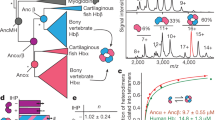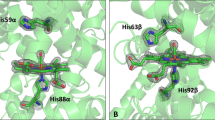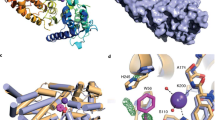Abstract
Haemoglobin binds oxygen cooperatively. In mammalian and bird haemoglobins the oxygen affinity is modulated by hydrogen and chloride ions, organic phosphates and CO2 (ref. 1), and the amino acid residues responsible for these so-called heterotropic effects have been identified2,3. In some fish haemoglobins these heterotropic effects are modified to adapt the fish to their specific habitats4. We have determined the functional properties and amino acid sequences of the haemoglobins in trout blood and in the Amazonian fish Pterygoplichthys pardalis (Pt HbI), which is a facultative air breather5–9. Trout HbI binds oxygen cooperatively, but shows no Bohr effect over the pH range 5–9 and no organic phosphate effect10. Pt HbI also binds oxygen cooperatively; its Bohr effect is small and reversed and its oxygen affinity is lowered by organic phosphates below pH 7.0–7.5 (ref. 9). Both haemoglobins represent substantial fractions of the total pigments in the red cells. We have now analysed the amino acid sequences of these two proteins to discover whether the particular residues thought to be responsible for the Bohr effect and organic phosphate binding in mammalian haemoglobins have been replaced by others in fish haemoglobins6,7,11.
This is a preview of subscription content, access via your institution
Access options
Subscribe to this journal
Receive 51 print issues and online access
$199.00 per year
only $3.90 per issue
Buy this article
- Purchase on Springer Link
- Instant access to full article PDF
Prices may be subject to local taxes which are calculated during checkout
Similar content being viewed by others
References
Antonini, E. & Brunori, M. Hemoglobin and Myoglobin in their Reactions with Ligands (North-Holland, Amsterdam, 1971).
Perutz, M. F. Br. med. Bull. 32, 195–208 (1976).
Kilmartin, J. V. Br. med. Bull. 32, 209–212 (1976).
Riggs, A. Fedn Proc. 35, 2115–2118 (1976).
Brunori, M. Curr. Topics cell. Regulation 9, 1–39 (1975).
Bossa, F. et al. FEBS Lett. 64, 76–80 (1976).
Bossa, F., Barra, D., Petruzzelli, R., Martini, F. & Brunori, M. Biochim. biophys. Acta 536, 298–305 (1978).
Riggs, A. Comp. Biochem. Physiol. 62 A, 257–272 (1979).
Brunori, M., Bonaventura, J., Focesi, A., Galdames-Portus, M. I. & Wilson, M. T. Comp. Biochem. Physiol. 62 A, 173–177 (1979).
Brunori, M., Falcioni, G., Fortuna, G. & Giardina, B. Archs Biochem. Biophys. 168, 512–519 (1975).
Savi, M. R., Barra, D., Amendola, K., Bossa, F. & Brunori, M. Proc. 26th Congr. SIB 195 (Lorenzini, Bologna, 1980).
Nishikura, K. Biochem. J. 173, 651–657 (1978).
Arnone, A. Nature 237, 146–149 (1972).
Airoldi, L. P. da S., Brunori, M. & Giardina, B. FEBS Lett. 129, 273–276 (1981).
Matthew, J. B., Hanania, G. I. H. & Gurd, F. R. N. Biochemistry 18, 1919–1928, 1928–1936 (1979).
Eaton, W. A. Nature 284, 183–185 (1980).
Author information
Authors and Affiliations
Rights and permissions
About this article
Cite this article
Barra, D., Bossa, F. & Brunori, M. Structure of binding sites for heterotropic effectors in fish haemoglobins. Nature 293, 587–588 (1981). https://doi.org/10.1038/293587a0
Received:
Accepted:
Issue Date:
DOI: https://doi.org/10.1038/293587a0
This article is cited by
Comments
By submitting a comment you agree to abide by our Terms and Community Guidelines. If you find something abusive or that does not comply with our terms or guidelines please flag it as inappropriate.



